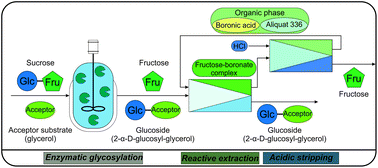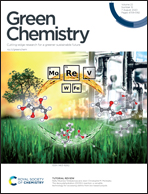Reactive extraction of fructose for efficient separation of sucrose-derived glucosides produced by enzymatic glycosylation†‡
Abstract
The disaccharide sucrose (α-D-glucopyranosyl-1,2-β-D-fructofuranoside) is a highly efficient donor substrate for enzymatic glucosylation reactions. A large number of commercially relevant glucosides are produced via this general route. Every sucrose-based glucosylation involves co-production of D-fructose in amounts corresponding to the target glucoside. A separation technology for selective removal, and efficient recovery, of the D-fructose co-product would be highly desirable as a generic platform for downstream process development. Here, we demonstrate organoboronate-complex reactive extraction of D-fructose into an 1-octanol/hexane (4/1, v/v) solvent using methyltrioctyl ammonium chloride as phase transfer catalyst and extractant. We show separation of the D-fructose co-product (100 mM) from equimolar mixture with 2-α-D-glucosyl-glycerol, a cosmetic ingredient that is manufactured industrially from sucrose and glycerol using sucrose phosphorylase. With the main parameters of extraction, stripping and organic phase recycling identified and their effect on product/co-product yield and purity characterized, we developed a three-step extraction process with alternating extraction and stripping stages that removed the D-fructose efficiently at 50 ml operating scale. 2-α-D-glucosyl-glycerol and D-fructose were cleanly separated and obtained in excellent purity (≥90%) at a recovery of 90% and 83%, respectively. Reactive extraction appears to be faster and more selective and resource-efficient than applicable alternatives for separation, including chromatography and membrane nanofiltration. Thus, the established extraction process is promising for industrial application. It could be generically useful to separate D-fructose from glucosides.



 Please wait while we load your content...
Please wait while we load your content...